Shakutate: Ladle Stand in Chanoyu
Utensils used for many Tea presentations are a kama, 釜, kettle, a heat source such as a portable fu-ro, 風炉, wind-hearth, or a sunken ro, 炉, hearth. In addition: a mizu-sashi, 水指, water-indicate, a ken-sui, 建水, build-water, and a futa-oki, 蓋置, lid-place, for the lid of the kettle. More elaborate Tea presentations include a shaku-tate, 杓立, ladle-stand, holds upright the hi-shaku, 柄杓, handle-ladle, handles water, and hi-bashi, 火箸, fire-rods, handles fire. These utensils, excluding the ro, may be displayed on a formal stand, dai-su, 台子, support-of, or a simple naga-ita, 長板, long-board.
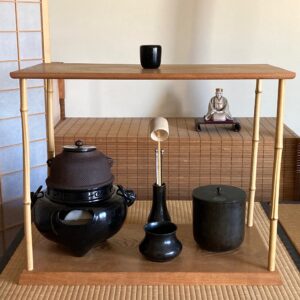
The utensils displayed on the jiita are from the left are the furo that contains a sumi-bi, 炭火, charcoal-fire, and kama, 釜, kettle, contains yu, 湯, hot water. Back center: shaku-tate, 杓立, ladle-stand, holds upright the hi-shaku, 柄杓, handle-ladle, handles water, and hi-bashi, 火箸, fire-rods, handles fire. Center front: ken-sui, 建水, build-water, contains waste water, and hidden within the kensui is a futa-oki, 蓋置, lid-place, for the lid of the kettle. At the right side is the mizu-sashi, 水指, water-indicate. Displayed on the tenita is a Rikyū-gata chū-natsume, 利休形中棗, Rikyū-style middle-jujube, containing ma-tcha, 抹茶, powder-tea, for making usu-cha, 薄茶, thin-tea. Each of the utensils are made of Kara-kane, 唐銅, Tang-copper, with the exception of the kama, which is made of tetsu, 鉄, iron, the hibashi, which are made of copper and silver, and the hishaku, which is made of take, 竹, bamboo.
This take-daisu was designed for use with the sunken ro, 炉, hearth, and is identified with Sen no Rikyū, and is also used with the portable fu-ro, 風炉, wind-hearth, as pictured. The daisu that is used in more formal Tea presentation is larger ‘shin-dai-su’, 真台子, true-support of.
In the time of Rikyū, measurements were made using the shaku. In the distant past, there were several lengths called shaku, and the standards today are the kane-jaku, 曲尺, bend-span, 30.303 cm, approximately one foot, and the kujira-jaku, 鯨尺, whale-span, 14.9606 cm or approximately 15 inches.
The shin daisu is covered throughout with mirror-finish black lacquer ‘shin-nuri’, 真塗, true-lacquer. The shin daisu is often identified with Take-no Jō-ō, 武野紹鴎, War-field Aid-gull, the Tea teacher of Sen no Rikyū.
The measurements of the shin daisu, taken from Rikyū Gata, by Sekai Bunkasha, are:
Height: 67 cm or 2.211 sun kane-jaku
Tenita: 42.8 cm x 91.3cm or 1.412401 x 3.012 sun kane-jaku
Jiita: 42.9 cm x 92.2cm or 3.042603 x 3.04 sun kane-jaku
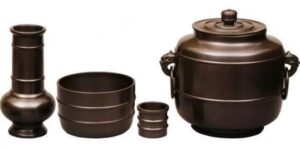
The shakutate, kensui, futaoki, and mizusashi are collectively called the kai-gu, 皆具, all-tools, and may be made of various material such as porcelain, pottery, wood, etc. The form of the shakutate varies greatly. One of the most familiar is bulbous with a tapered neck, as pictured above. This form loosely resembles a more-fully open tsuru-kubi, 鶴首, crane-neck, a hisago, 瓢, gourd. Note the form of the shakutate is a composite of a sphere manifesting In, 陰, Yin, negative, and a shaft manifesting Yō, 陽, Yang, positive. Some later designs of the shakutate have a greater gradual transition between the forms.
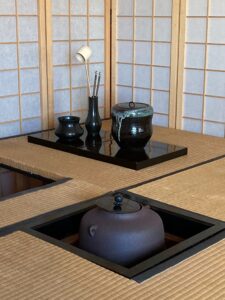
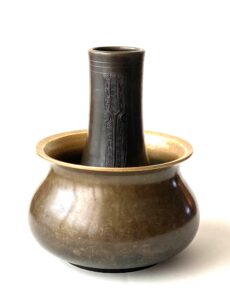
Shaku-tate, 杓立, ladle-stand, placed inside a ken-sui, 建水, build-water, in the form called e-fugo, 餌畚, fee-basket. The kaigu are designed as a group that, theoretically, nest inside one another and transported as a single unit. The mizusashi is the base, the kensui is placed in the mizusashi, the shakutate inside the kensui, the cylindrical futaoki is slipped over the neck of the shakutate, the lid, futa, is placed on the mizusashi. The mizusashi often has loose rings for moving the unit.
Rō-soku-tate, 蝋燭立, wax-lamp-stand, in the form of a tsuru, 鶴, crane, holding a lotus-form candle pricket, standing on a kame, 亀, turtle. It is believed the world is supported by a great turtle that is a water creature. The crane holds fire, which is Yō, 陽, Yang, positive, penetrative, and the water of the turtle is In, 陰, Yin, negative, receptive.
Together, the turtle and the crane can be symbolically seen manifest in the shakutate.
The kensui, displayed on the jiita of the daisu, is located on the trigram ☵, Kon, 坤, Earth.The turtle/tortoise, kame, 亀, also may be likened to the kensui. The tortoise is a land creature and, therefore, symbolic of the earth.
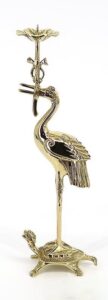
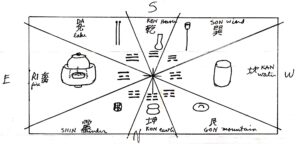
Diagram of the cha-dō-gu, 茶道具, tea-way-tools, placement on the ji-ita, 地板, earth-board, of the dai-su, 台子, support-of, and their affiliation with the Ha-kke, 八卦, Eight-divination signs of the Eki-kyō, 易経, Change-sutra. Included in the diagram are the lid of the mizusashi and the futa-oki, 蓋置, lid-rest. The illustrated futaoki is a go-toku, 五徳, five-virtues, a ring-trivet, which is used with the ring down or up.
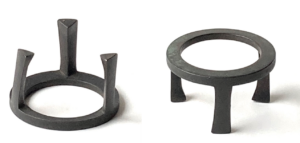
If the kama is supported on a gotoku, a gotoku futaoki is not used, however, with a kama supported by something other than a gotoku, the gotoku futaoki was a prime choice of Sen no Rikyū, 千利休, Thousand Rich-quit. It is essential to know that the Kanji for eki, 易, change, is part of Rikyū’s name, Sō-eki, 宗易, Sect-Change, by which he was known throughout most of his life.
Relevant to the present study, the focus is on the shaku-tate, 杓立, ladle-stand.
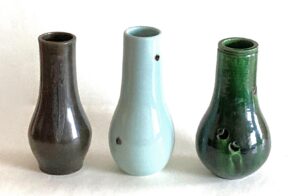


The height of the shakutate is probably intended to be 6 sun kane-jaku. The shakutate, as its name indicates, is the stand for the hishaku, with no reference to the hibashi, even though they are also displayed in the shakutate. The number 6, roku, 六, is symbolic of Infinity in Time. The length of the hishaku is 14 sun kane-jaku. When placed into the shakutate, the visible part of the hishaku is 8 sun kane-jaku. The number 8, hachi, 八, is emblematic of sue-hiro, 末広, ends-wide, which is symbolic of Infinity in Space. Therefore, the shakutate is symbolic of both Infinity in Time and Space.
The location of the shakutate on the jiita of the daisu is identified with the Ekikyō trigram, ☰, Ken, 乾, Heaven. According to the Ekikyō, the arrangement of the trigrams, places the trigram Ken in the South, opposite the trigram, ☷, Kon, 坤, Earth, which is located in the North. This arrangement places the teishu, metaphorically, in the North.
It should be understood that when readying one’s self to prepare Tea in Rikyū’s yojōhan chashitsu, the teishu faces North, the seat of deity. This is true regardless of the actual orientation of the Tearoom. When the daisu is used to prepare Tea, it is placed in the northwest corner of the room. With the presence of the daisu, the arrangement of the Ekikyō trigrams, teishu sits in the North acting on behalf of the deity in the ‘true’ north.
The kensui is displayed on the jiita of the daisu on the area of the trigram Kon. The kensui becomes filled with water during the Tea presentation. According to the Ekikyō, Water is identified with the North. The hishaku ladles water and is located at the front of the shakutate, the hibashi handles fire and is located at the back of the shakutate. Both aspects reinforce the placement of the teishu ‘in the North’. This arrangement and placement of the hishaku and the hibashi is more complex.
The number 5, go, 五, is symbolic of Kū, 空, Void, which by transference to the physical world is symbolic of Moku, 木, Wood, and growth, life itself. It is the fifth of the Go-rin, 五輪, Five-rings, five principles, and the Go-gyō, 五行, Five-transitions, the five physical elements.
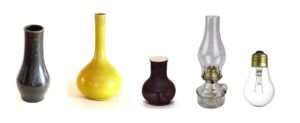
Oil lamp glass chimney prevents wind from extinguishing the flame, and channels smoke. Light bulb filament created by Thomas Alva Edison with a piece of bamboo taken from the temple grounds of Mi-i-dera, 三井寺, Three-wells temple, more formally named On-jō-ji, 園城寺, Garden-palace-temple, Ō-tsu, 大津, Great-port.
Thomas Alva Edison (1847–1931), American inventor, developed the electric incandescent light bulb, using bamboo as its filament. The bamboo was from the precincts of Iwa-shi-mizu Hachi-man-gū, 石清水八幡宮, Rock-pure-water Eight-banner God-palace. In 1934, a monument was constructed to commemorate Edison and his achievements.
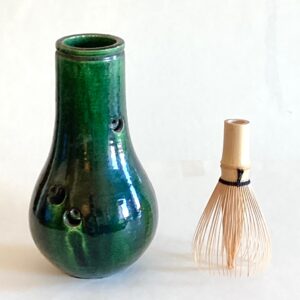
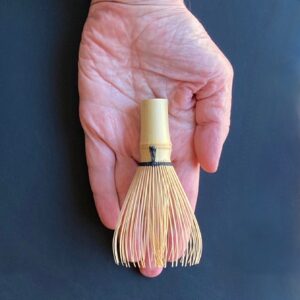
The chasen is shown with the handle upright, which is in accord with the growth direction of the bamboo, as though the tines of the whisk are like bamboo roots growing out of the tea. Compare similar proportions of the whisk and the hand. When withdrawing the chasen from the chawan, the left hand is held near the chasen.
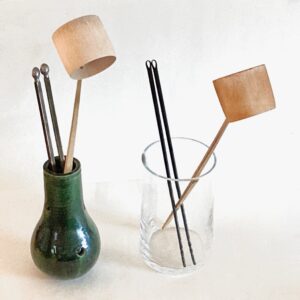
The shaku-tate, 杓立, ladle-stand, on the left is shown as it would be displayed on the ji-ita, 地板, earth-board, of the dai-su, 台子, support-of, with the hi-shaku, 柄杓, handle-ladle, leaning forward, which establishes the front, shō-men, 正面, correct-face. The hishaku handles water, which is In, 陰, receptive, and the hi-bashi, 火柱, fire-rods, handle fire, which is Yō, 陽, penetrative.
Where there are three of something, one is forward, and at the front, shōmen; such as the feet of the furo or an incense burner. The hibashi are leaning away at the back. The glass container’s transparency shows the crossing of the hishaku and the hibashi within the shakutate. It also reveals the change of ‘shōmen’.
The hishaku is one thing, the hibachi are two things – one thing is shō-men, 正面, correct-face. The relationship of the hidden ends of the hibashi and the hishaku changes the shōmen. The visible and invisible are manifestations of In and Yō, the visible is In, because it is a thing, and the present but invisible is Yō.
This follows the direction of Sen no Rikyū in one of his Hundred Poems: Rikyū Hyaku-shu, 利休百首, Rich-quit Hundred-necks:
Futaoki ni mitsu ashi araba hitotsu ashi mae ni tsukau to kokoroete oke
蓋置に三つ足あらば 一つ足前に使うと心得ておけ
Lid-place has three legs if. has one leg, front in use and mind keep (know)
This poem can refer to the use of the gotoku futa-oki that is a ring with three legs. When it is used as a futaoki, one of the legs is forward, shōmen, front, and the ring is up. When it is displayed, it is a gotoku, the ring is down, the legs are upward, two legs are the shōmen. The shakutate with the hishaku and the hibashi, grant the teishu control over water and fire bestowed by heaven.
FOr further study, see also: Hibashi and Tea in July

